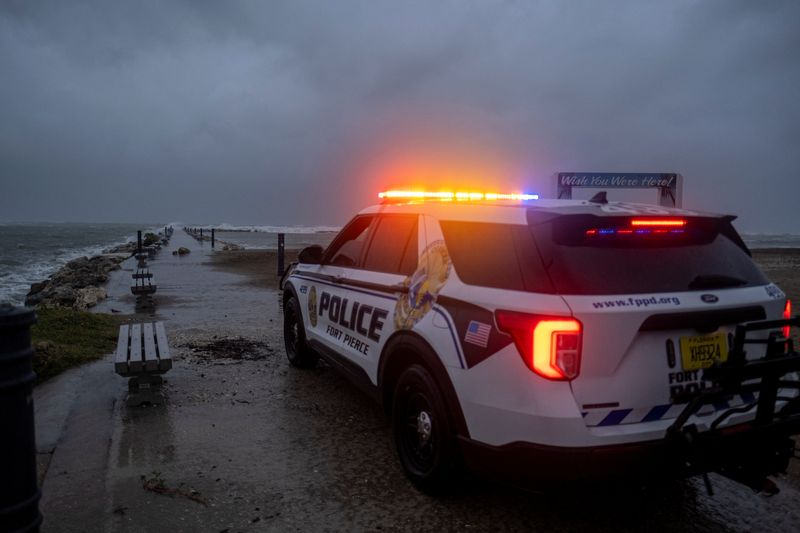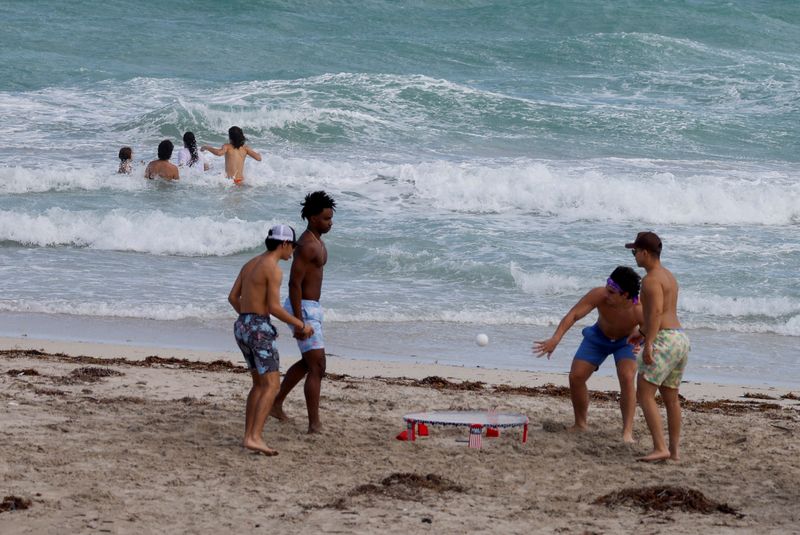By Brian Ellsworth and Jasper Ward
MIAMI (Reuters) -Hurricane Nicole plowed through the Bahamas on Wednesday as it was upgraded from a tropical storm, lashing the West Indies archipelago nation with howling winds and raging surf while churning ever closer to Florida's Atlantic shoreline.
Nicole was packing sustained winds of up 75 mph (120 kph) as it made landfall on Grand Bahama Island, and was expected to move ashore over the eastern seaboard of Florida late on Wednesday or early Thursday, the Miami-based National Hurricane Center reported.
Authorities in several counties along Florida's east coast issued mandatory evacuation orders or advised residents in low-lying areas along the shore and on barrier islands to seek shelter.
"This is the last window of opportunity to secure your families and to secure your properties and possibly save some lives," Volusia County Sheriff Mike Chitwood said in a video posted online, urging residents to heed evacuation orders.
Chitwood said "dozens upon dozens" of oceanside buildings, including high-rise condominiums, were left structurally unsafe in Volusia County after Florida's last major storm, Hurricane Ian, struck six weeks ago, with some now "in imminent danger of collapsing" when Nicole strikes.
Video footage posted on social media showed ocean waves crashing up onto streets and parking areas under foreboding skies.
Even before reaching hurricane strength, the storm unleashed "extensive flooding" across much of the Bahamas, including the islands of Grand Bahama, Eleuthera, Andros and the Abacos, National Emergency Management Agency chief Captain Stephen Russell told a news conference.
Grand Bahama, Bimini and the Berry Islands in the northwest corner of the island nation remained under a hurricane warning.
As the storm closed in earlier on Wednesday, some residents fled their homes amid fierce winds and flooding.
Ann Wilmore, 60, of Dundas Town on the island of Abaco, left her trailer and sought refuge in a nearby house. "I'm monitoring the weather very closely," Wilmore said by telephone.
The Bahamas Department of Meteorology reported a nearly 4-foot (1.2 meters) storm surge north of the town of Treasure Cay on Abaco. Waves flooded at least one road in Nassau, the capital, officials said.
The storm's center was expected to pass well north of Miami, Florida's most populous city. But Governor Ron DeSantis declared a state of emergency for 45 counties, and a hurricane warning remain posted for a 240-mile expanse of Florida's Atlantic seaboard from Boca Raton north to around Flagler Beach.
The National Hurricane Center also issued storm-surge advisories for much of Florida's east coast, warning that wind-driven waves were expected to wash over beaches and rush inland to flood low-lying areas well beyond the shore.
'SURROUNDED BY WATER'
Storm surges caused widespread devastation to Florida's Gulf Coast when Hurricane Ian crashed ashore on Sept. 28, causing an estimated $60 billion in damage and killing more than 140 people.
DeSantis urged residents to prepare.
"Please make a plan," he told a news conference. "This is likely to be a storm making landfall and will affect huge parts of Florida."
Although curiosity seekers ventured out to catch a glimpse of the roiling surf, pose for cyclone "selfies" or capture a video clip of the gathering storm, many were taking the situation more seriously.
"We have had a lot of flooding within the last couple of storms," said Leanne Hansard, 53, a Daytona Beach resident who was boarding windows to her family's insurance office. "Florida is surrounded by water on all sides, so eventually you're going to have water."
At the governor's request, the Federal Emergency Management Agency approved emergency protective assistance for the 45 counties most likely to be affected.
State officials opened 15 emergency shelters across the region, activated 600 National Guard troops for emergency response and recovery efforts, and placed 1,600 utility workers on standby to restore power knocked out by the storm.
More than a dozen school districts were closed on Wednesday and more than 20 school districts across the state were scheduled to be closed on Thursday.

Orlando International Airport announced it was ceasing commercial operations at 4 p.m. (2000 GMT) on Wednesday.
The storm was expected to move into southern Georgia on Thursday before moving into the Carolinas on Friday.
